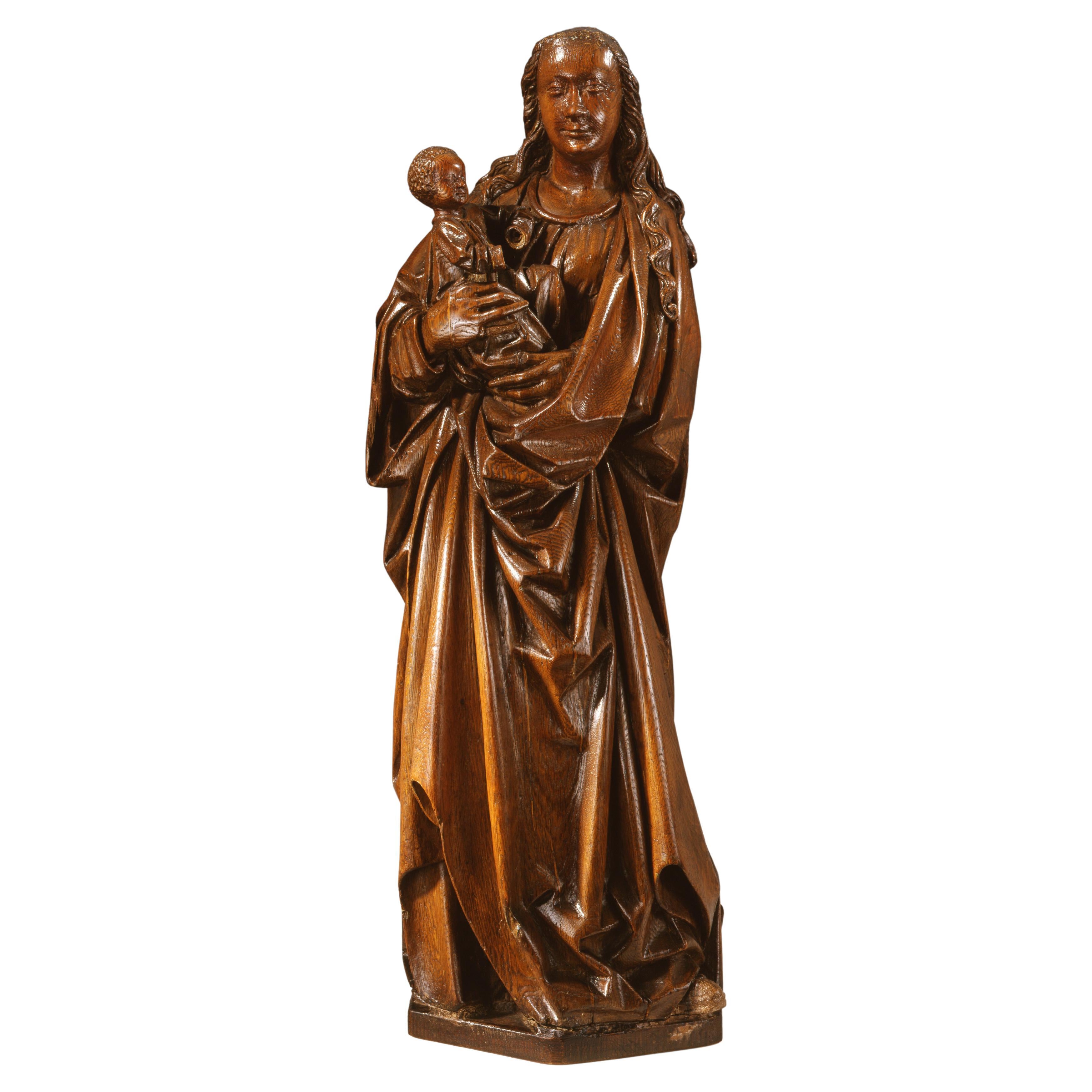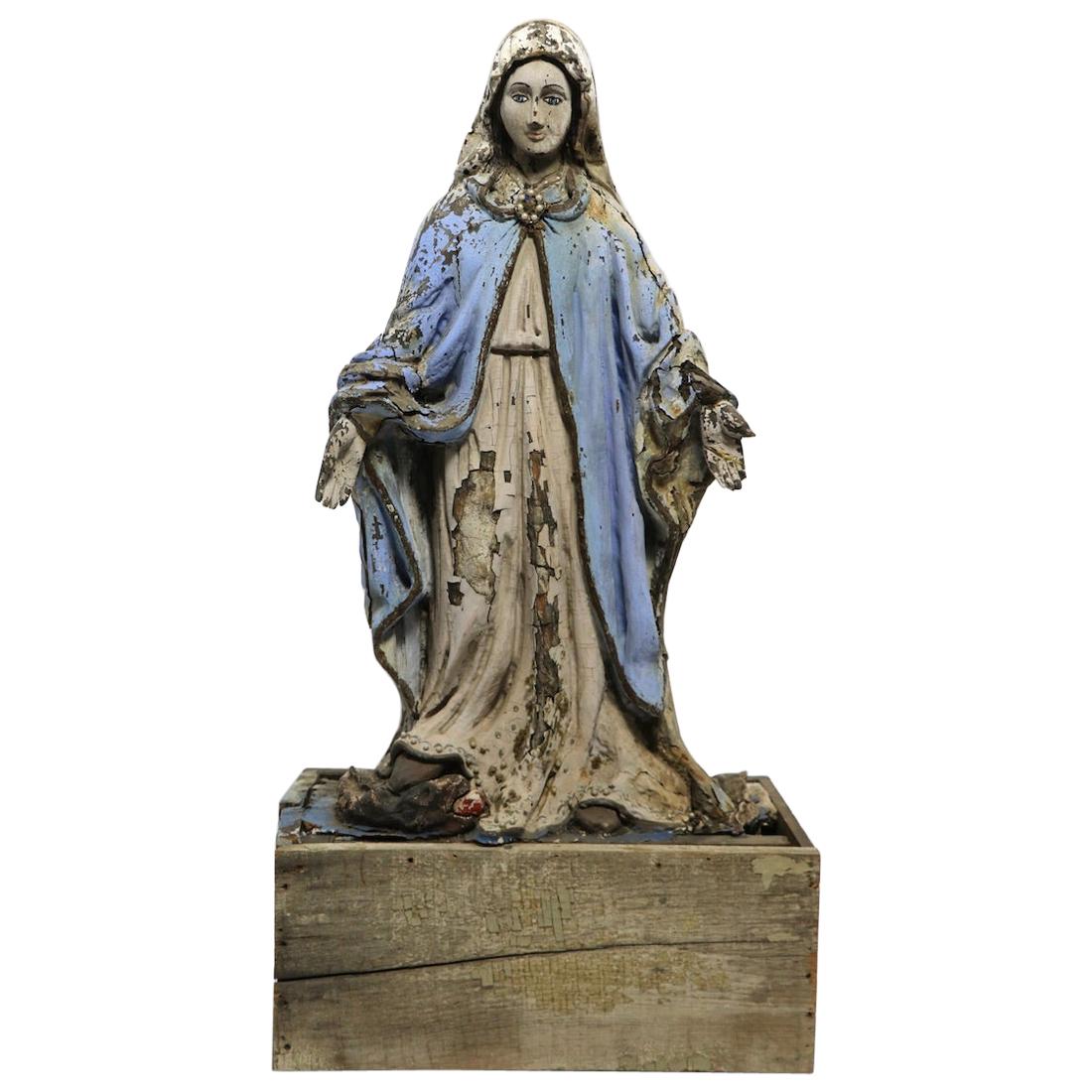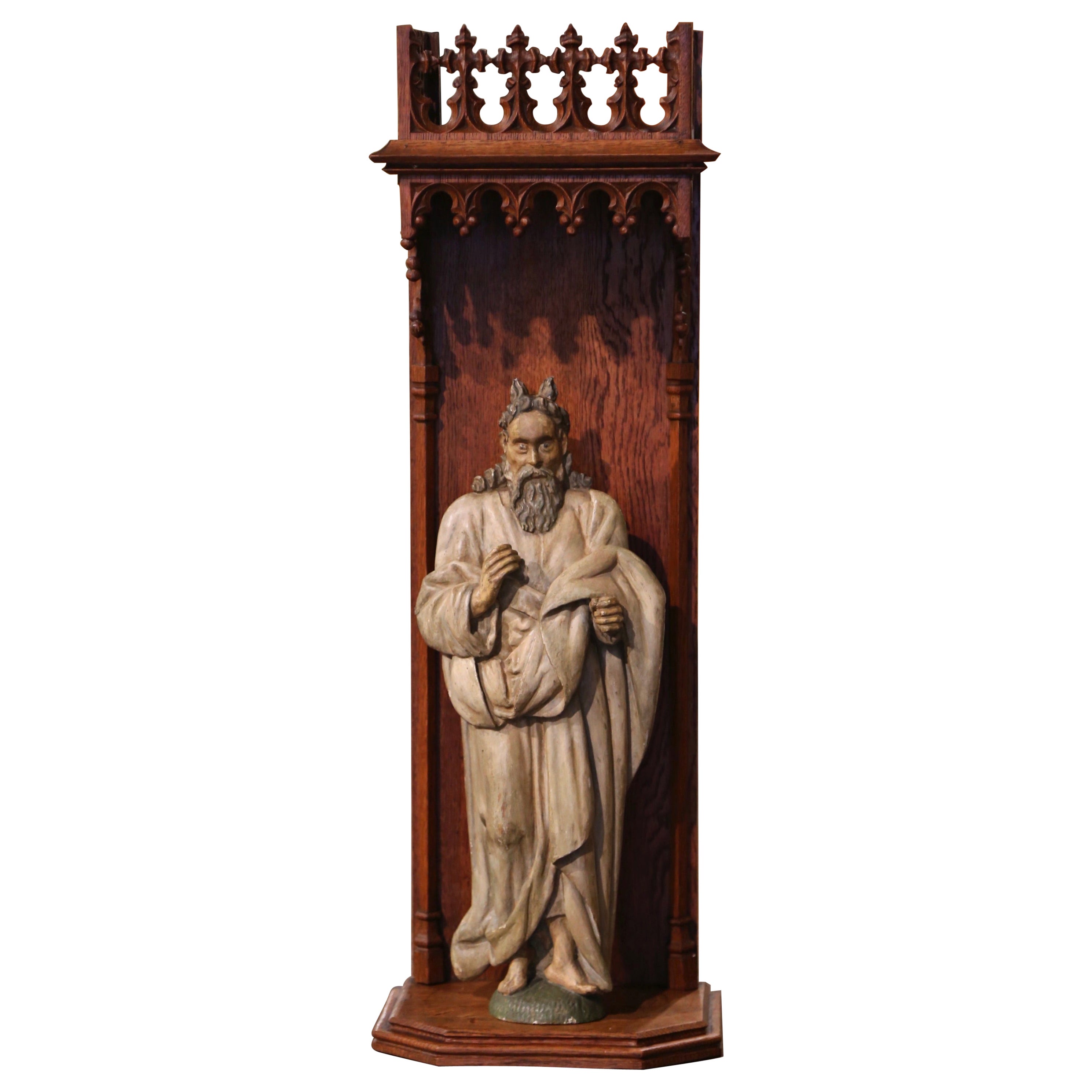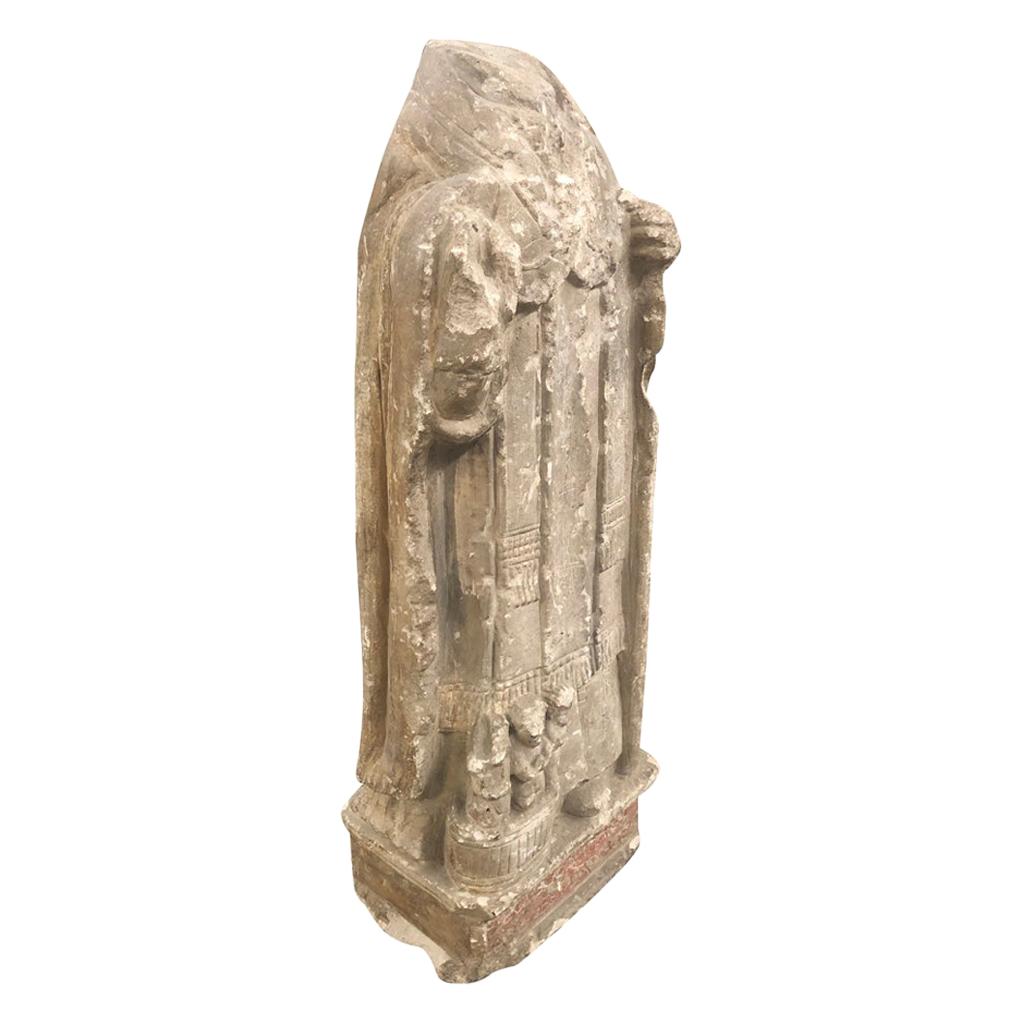Items Similar to Gothic Carved Oak Statue – Virgin of the Annunciation
Want more images or videos?
Request additional images or videos from the seller
1 of 10
Gothic Carved Oak Statue – Virgin of the Annunciation
About the Item
15th Century Oak Wood Sculpture of the Virgin of the Annunciation beside a lectern supporting an opened book, the Virgin with both hands upraised ( one repaired) turning slightly to the left, her demeanour redolent of strength, compassion and benignity.
Franco Flemish origin, circa 1480, 56 inches in height x 26 inches wide.
Provenance : Lot 347, The Notable Art Collection, New York, April 1949, Joseph Brummer Collection Part 1
- Dimensions:Height: 56 in (142.24 cm)Width: 26 in (66.04 cm)Depth: 15 in (38.1 cm)
- Style:Gothic (Of the Period)
- Materials and Techniques:
- Place of Origin:
- Period:
- Date of Manufacture:circa 1480
- Condition:Repaired: Repairs have been made to one of the outstretched hands. It's hard to know exactly when this work was carried out, however it was before Joseph Brummer auctioned it in 1949 as it's mentioned in the online record of the auction. Wear consistent with age and use. Minor losses.
- Seller Location:Maidstone, GB
- Reference Number:
About the Seller
No Reviews Yet
Vetted Seller
These experienced sellers undergo a comprehensive evaluation by our team of in-house experts.
Established in 2021
1stDibs seller since 2023
Typical response time: 1 hour
- ShippingRetrieving quote...Ships From: Maidstone, United Kingdom
- Return PolicyA return for this item may be initiated within 14 days of delivery.
More From This SellerView All
- Pair of 16th Century Carved Oak SaintsLocated in Maidstone, GBA Pair of 16th Century Oak Saints: One being a male depicted wearing a long hooded cloak held together with a brooch over a flowing tunic tied at the ...Category
Antique 16th Century European Gothic Figurative Sculptures
MaterialsOak
- Antique Oak Sculpture – The Grief of MaryLocated in Maidstone, GBA Late 15th/Early 16th Century Oak Sculpture depicting ‘The Grief of Mary’, carved almost in the round with Mary wearing a head scarf, neckerchief and...Category
Antique 15th Century and Earlier European Gothic Figurative Sculptures
MaterialsOak
- Pair of 15th/16th Century Carved Oak SaintsLocated in Maidstone, GBA Pair of Late 15th or Early 16th Century Oak Saints carved in high relief and raised on polygonal bases. The female depicted standing in contrapose with low...Category
Antique 15th Century and Earlier European Gothic Figurative Sculptures
MaterialsOak
- Early 16th Century Stone Carving - 'The Death of a Prelate'Located in Maidstone, GBAn Early 16th Century Stone Carving with polychrome : 'The Death of a Prelate'. The enthroned figure of a Bishop surrounded by attendants and surmounted by celestial angels.Category
Antique 16th Century European Gothic Figurative Sculptures
MaterialsStone
- 16th Century Giltwood and Polychrome Group Carving – 'God and Mary'Located in Maidstone, GBA 16th Century Giltwood and Polychromed Carved Group depicting God and Mary seated on a plinth.Category
Antique 16th Century European Gothic Figurative Sculptures
MaterialsGiltwood
- 'Horse in the Rain V' Bronze Sculpture by Elisabeth FrinkBy Elisabeth FrinkLocated in Maidstone, GB'Horse in the Rain V' bronze sculpture by Dame Elisabeth Frink Created in 1985 Signed on the base 'Frink 5/8' Provenance : Original dealer (Beaux Arts) invoice from 1987Category
Vintage 1980s British Animal Sculptures
MaterialsBronze
You May Also Like
- Gothic Virgin and Child with a PhylacteryLocated in Saint-Ouen, FRThis Virgin and Child is wearing clothes with a limited number of folds and showing a thickness characteristic of the Burgundy region. As a result of the presence in the region of th...Category
Antique 15th Century and Earlier French Gothic Figurative Sculptures
MaterialsWalnut
- Gothic Virgin and Child from FlandersLocated in Saint-Ouen, FRExhibition Museum Cantini, 1952, The art of the Middle Ages in the Marseille collections, n°101 Provenance Former collection Louis Bresset (before 1952) Former collection Profe...Category
Antique 15th Century and Earlier Dutch Gothic Figurative Sculptures
MaterialsOak
- Carved Wood Polychrome Virgin Mary StatueLocated in New York, NYExquisite and compelling wood statue of the Virgin Mary with polychrome paint finish. Well executed, and finely carved we believe it's 19th C Continental, or possibly US in origin. U...Category
Antique 19th Century Spanish Folk Art Figurative Sculptures
MaterialsWood, Paint
- Mid-18th Century French Carved Polychrome Statue of Moses in Oak NicheLocated in Dallas, TXCrafted in France circa 1760 and resting in a carved oak niche, the figure depicts the prophet Moses, the most important prophet in Judaism and Christianity. Moses is best known from the story in the biblical Book of Exodus and Quran as the lawgiver who met God face-to-face on Mount Sinai to receive the Ten Commandments after leading his people, the Hebrews, out of bondage in Egypt and to the "promised land" of Canaan. He is represented with horns on top of his head. The horns came about because of an ambiguity of the Latin version of Exodus 34, 30. After being addressed by God on top of Mount Sinai and given the Tablets of the Law containing the Ten Commandments, Moses descended to his people in the desert. His face was seen to shine with a divine light. (The first Moses with horns was commissioned in 1505 by Pope Julius II for his tomb; it was based on a description in chapter 34 of Exodus in the Vulgate, the Latin translation of the Bible used at that time). The religious and biblical item...Category
Antique Mid-18th Century French Gothic Religious Items
MaterialsOak
- Polychrome carved wood Virgin and Child from the 15th CenturyLocated in Saint-Ouen, FRPOLYCHROME CARVED WOOD VIRGIN AND CHILD FROM THE 15TH CENTURY ORIGIN: SOUTH GERMANY, SWABIA, NUREMBERG REGION PERIOD: 15th CENTURY Height: 94,6cm Width : 28 cm Depth : 18 cm Lime wood Original Polychromy Good state of conservation From 1430 onwards, sculpture underwent a profound stylistic renewal which continued until 1530, the so-called late Gothic period. In the Germanic countries, original sculptures flourished in an expressive and sensitive vein. This renewal was inspired by the art of Nicholas of Leiden, who was active in Strasbourg in the 1460's. His style broke with the refined and delicate art of the international Gothic style in force throughout Europe around 1400. The figures became more authentic and realistic. The bodies became denser. Clothes are animated by deep, broken folds, the fabrics are heavy and have a great decorative value. In addition, the polychromy is intended to be illusionistic. The painting makes it possible to restore the texture of the materials, the richness of the textiles and the natural skin tone of the characters. The dissemination of images through engraving and the great mobility of the artists led to the success of this style, which conquered the Upper Rhine, Swabian, Tyrolean and Franconian regions, contributing to the formation of a common stylistic identity in these regions. The economic boom in the flourishing German cities was conducive to the development of original production. Attracted by this prosperity, numerous workshops were set up in order to meet the orders of religious communities, the Church and the laity, including a clientele of middle-class rockers. This precious Virgin and Child is depicted standing on a crescent moon, her head encircled by a crown of tall flowers. Her long wavy hair spreads over her shoulders, framing her beautiful oval face. Under fine eyebrows drawn with a brushstroke, her almond-shaped, slightly drooping eyes look at the Child with infinite softness. She is dressed in a long red dress with a rounded neckline, belted under the chest. The heavy fabric of her dress spreads out in broken folds at her feet. On her shoulders she wears a golden cloak. The drapery has deep folds. She holds out her right hand while she holds the Christ Child with her left. Christ, with his well-defined hair, is naked. His cheeks are highlighted with red, he holds an apple in his left hand and with the other hand makes a sign of blessing towards the faithful. Virgins with Child on a crescent moon were very popular in the second half of the 15th century, especially as the central subject of altarpieces in southern Germany and Austria. The crescent moon on which Mary is standing is reminiscent of the Woman of the Apocalypse. Often equated with the Virgin Mary. This episode is taken from the Book of Revelation (12:1-6) 1 Then a great sign appeared in heaven: a woman clothed with the sun, with the moon under her feet and a crown of twelve stars on her head. ; 2 She was pregnant, and she cried out because she was in labor, in pain from giving birth. ; 3 Then another sign appeared in heaven: it was a great fiery red dragon, with seven heads and ten horns, and seven royal crowns on his heads. ; 4 His tail swept down a third of heaven's stars and threw them to the earth. The dragon stood in front of the woman who was about to give birth so that when she gave birth, he might devour her child. ; 5 She gave birth to a son, a male child who is to rule all the nations with an iron rod. Her child was snatched up to God and his throne. ; 6 Then the woman fled into the desert, where God has prepared a place for her. There she will be taken care of for one thousand two hundred sixty days. Some theologians see in this woman a reference to the Virgin Mary and in the child, Jesus. This remarkable work is a very fine example of sculpture from Swabian workshops in the last decades of the 15th century. It presents all the characteristic stylistic elements: a highly girdled silhouette, an abundant drapery with angular folds, but also a great physical presence accentuated by the polychromy that restores the anatomical details. This group is made of a wooden log. The deep folds of the drapery highlight the movement of the Virgin holding the child. Bibliography : Sophie Guillot de Suduiraut, Dévotion et Séduction, Sculptures souabes des musées de France, vers 1460-1530, Paris musée du Louvre-Éditions somogy, 2015 “Revelation 12 - Common English Bible...Category
Antique 15th Century and Earlier German Gothic Figurative Sculptures
MaterialsWood
- Gothic Period Carved Stone Statue of Saint NicholasLocated in Atlanta, GAA wonderful Gothic period hand carved stone statue of Saint Nicholas from the Avignon area of France. The now headless Saint Nicholas holds his staff an...Category
Antique 16th Century French Figurative Sculptures
MaterialsStone
Recently Viewed
View AllMore Ways To Browse
Mid Century Ballerina Statue
Moreau Bronze Kiss
Moreau Bronze The Kiss
Peggy Mach
Serge Yourievitch
Alabaster Buddha Heads
Antique Michelin Man
B Boschetti Roma
Bedouin Warrior Sculpture
Curtis Jere Balloon
Dancing Fawn Sculpture
E Gazzeri
Gallo Glassware
Grand Tour Boxer
Hercules And Antaeus
Hercules Antaeus
Herend Bunny
Hermes Cloak





